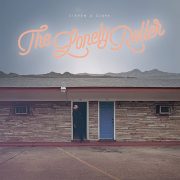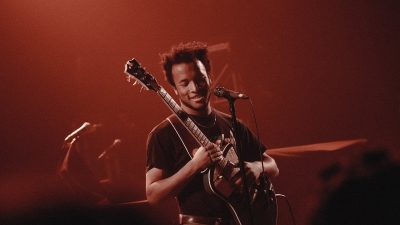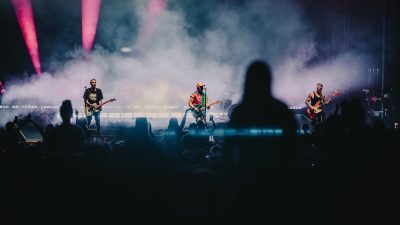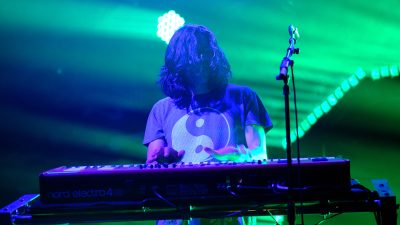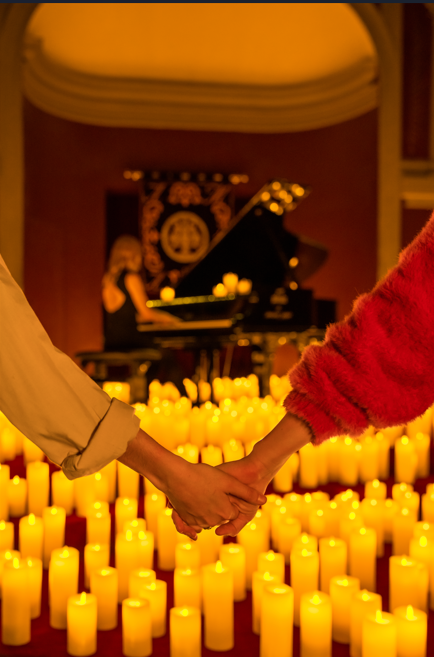How FME won the summer and this festival season
I can’t tell what time it is, but by the looks of it, the sun is about to come up. The area around the building is still crowded with people and where I am, at that very moment, three musicians I had met only a few hours ago are beatboxing on a random staircase…
The Festival De Musique Émergente (FME) is unique by its origin and in its nature. Rouyn-Noranda is a small town in Southwestern Quebec, the center of the Abitibi region. The town grew (years ago) around the mining industry and as the mining industry subsided while the population grew, the people in Rouyn-Noranda came up with new ways to occupy their time and bring people into the region – a variety of festivals from music to film and food.
FME was founded 13 years ago by a small, but ambitious group of people. “People used to go to Montreal to see music,” says Sandy Boutin, festival founder, “and it’s a long journey, so we decided to bring musicians here.” The goal was to create a music festival that everyone in the city can be a part of in some way and learn about new and emerging artists. The organizers get hundreds of submissions and a small committee decides on who to invite, but not without disagreements, laughs Boutin. Over the years FME has become a cultural center and a place where industry professionals from across the world network (read: party) and discover new music.
For most attendees, the FME experience begins with a journey. Whether it is a road trip or a suspiciously small plane that makes a stopover, you quickly realize you are about to enter into the “middle of nowhere” – a quote that can be boldly attributed to half of the people that I met that weekend (read: a lot).
Although Rouyn-Noranda is one of the largest cities in Quebec, it is small and could hardly be called a city (especially if you come from one of those big ones like Toronto or Paris). The entire town is transformed by the FME crew and volunteers: a variety of art installations indicate participating restaurants and pubs, the windows of local shops are plastered with festival posters and people are wandering the town with branded yellow cups of beer, hopping from venue to venue collecting stamps and nothing seems to be further than a 10-minute walk. “So we can just take our beer from here to there!?” – Yes, yes you can. You can also purchase the said beer at the nearby grocery store and smoke on the patio. To no surprise this freedom of intoxication creates a very civil and friendly environment, no one is in a rush to find the last call and when one comes there are other options.

The heart of the festival is the artist village, which by day is a family playground and by night a hub for all FME activity and a place where you might find people you lost. Working our way through the various crowds, past a rather cheerful metal performance, we find ourselves at the Cabaret De La Dernière Chance for Heat, a Montreal-based, English-speaking quartet who describe their music as feel-good rock. True to that description Heat is a lo-fi rock band performing, in a relaxed attitude, the type of music you could imagine yourself skateboarding to in a sunny park. Susil Sharma’s voice is laid back, almost lazy, but it draws in a large crowd, filling the Cabaret from the back to the front.
Over the 4 days that FME ran, the festival showcased 70 bands and solo artists plus over 15 surprise shows that you learned about an hour or two before they happened. “Pst pst!” there is one in the alleyway on your way to dinner or one in the pop-up record shop near the pop-up bar, and then there was that one in the hotel room you could just stroll into. While 70 might not seem like a particularly large number in comparison to events like SXSW, this festival is not about hustling and the obvious concentration on quality over quantity is one of the things that makes it easy to enjoy.
A handful of shows took place during the day in various cafes and alleyways and one of the biggest standouts for this crew of one was Hein Cooper. A solo performer based in Australia, whose charming looks and voice created a bit of traffic on the sidewalk, but past that face is a very promising artist. Cooper’s music might, at first listen, fall into the folk singer/songwriter bag, but further listening is a lot more complex and more at home within the indie-electronic pop genre. Being an Indica Records artist, Cooper is no stranger to Montreal where he recorded his debut self-titled EP last year. While he has gone through a range of cities across Canada and the U.S. his name is not yet well recognized, but it undoubtedly will be sooner than later.
FME streets don’t really get busy until after dinner, but somewhere out there is a house party, and just nearby there is a pool party, and in half an hour we are invited to the SOCAN BBQ where my dinner date was a 2-hour impromptu conversation with Ken Fox from The Fleshtones. “I joined the band 30 years ago, but they still call me the new guy” he chuckles. “Isn’t this what we’re here for – to meet people?” points out a fellow journalist. Since my arrival, people kept telling me The Fleshtones are a must-see show. The band has been around for a good four decades and has stacks of records and thousands of shows lining their way into people’s iPods. This is an original rock band, with matching (shiny) outfits and riotous, contagious on-stage energy. People who saw them on Friday saw them on Saturday, and it seems like no one had missed a Fleshtones show.
Earlier that night, L’Agora des Arts, a church across from the artist village, filled in for a magnetic performance by Parisian rocker, Jeanne Added. Her strongly opinionated fan base left the venue as soon as Added wrapped up but in no time the room filled with another, equally passionate set of fans for San Francisco’s The Dodos. Meric Long and Logan Kroeber are a progressive indie rock duo, Kroeber on drums/vocal support and Long on vocals/guitar. The band has been around for quite a few years and has developed a distinct sound described by Pitchfork as a “symbiotic back and forth [between] alternately-tuned guitar sounds and insanely intricate drum patterns.” Though they do dance in their music videos dancing is not what you will see on stage, only rocking, lots and lots of subtle rocking out.

Late night Saturday turned into a rave at Petit Théâtre du Vieux Noranda, a concert venue located in the artist village hub. Starting at 2 a.m. with Molly, a rising star in the Parisian club scene, the venue began to fill with deep house and techno. Molly’s music is clean and direct much like her on-stage presence – she herself didn’t move at all behind the decks, but that didn’t seem to stop the crowd from limbering up properly before the highly anticipated Das Mörtal set. Born Cristóbal Cortes, Mörtal is heavily inspired by 90s German techno and that influence is immediately obvious. This is dirty, loud, industrial techno accompanied by seizure-inducing strobe lights just like it was meant to be heard. The evening came to a withering end sometime before 5 a.m. with IPHAZE. A French duo consisting of Patrice Cadiou and Jean Davoisne, between the two of them, create a visually captivating melodic bass set using analog and digital instruments in combination with mechanically produced samples. And on the way out a stranger (at that time) taught me how to pin my hair with a chopstick.

Sunday proved to be an incredibly sunny day and after familiarizing myself with the city, I realized that a single street that changes names a couple of times can take you from one end of FME to the other. In less than 20 minutes from the further end, I made it over to a packed and sweaty Café-Bar L’Abstracto for a Chapelier Fou performance. Within the first few strings, France’s Louis Warynski’s solo project became a four-piece ensemble that enveloped the entire audience with its pure charm and instrumental originality. Switching from string instruments to keyboards and a variety of electronic music equipment, the four members were creating songs right in front of the audience, making it a performance impossible to forget. Full disclosure: this is a show that was just short of magical and really should be seen live.

The evening shows were beginning to pop up in smaller venues across town and since Safia Nolin came as a highly recommended performance, I dove into the hot pit of fire that L’Agora des Arts had become to listen to some sad, sad French music. Her lyrics will tear your soul to pieces, but her personality, clearly unmoved by her own sadness, brings vain oddness to her performance: “Hi, I’m 23…I like Harry Potter…and I sorta, kind of like this festival”.
Sunday night at FME 2015 has become known as a metal night. A variety of heavy metal bands had been playing around throughout the weekend, but on this night in particular the Petit Théâtre had been transformed into a metal hub, hosting Canada’s Barricade, Abitibi-native death metal band Abitabyss and one that was on everyone’s list – Fleshgod Apocalypse. If the name does not say enough, synchronized hair flips, black tuxedos, and the opera singer really do get the point across.
To wrap up the festival, Scène Paramount opened its doors to Kid Koala. Wearing a signature Koala suit and surrounded by boxes of vinyl, Eric San went right into his most popular tracks, but as the suit came off San began to introduce new mixes such as The Bug’s “Function” and “Poison Dart” and to my surprise a remix of a more mainstream track, “Goooo” by TNGHT. Having roots in the Toronto music scene, this is the kind of stuff that sets the party on fire for me, it’s the grimy trap that has everyone tucked in their elbows and bouncing, but this crowd, though clearly enjoying the show, was not on the same page. No one else is excited about British grime? Well, all right then…

About an hour later, San had rather abruptly ended his set and the crowds began to wander towards hotels, but that was only Part I of the evening for many. Multi-venue festivals that bring in people from across the world have a tendency to get locals and visitors alike more relaxed and open. If you arrive alone you will not remain alone, and you will likely not leave with the people you came with. Your newly acquired friends will wander off and be replaced by newer friends and those small groups of likely soon-to-be strangers (but not always) become your squad for the night. The after-party turns into the after-after-party while the people in the squad swap in and out as some of them split off home.
As a general rule, this late at night, no one knows what time it is: we’ve been out for hours and 3 hours ago everyone gave up on looking for a phone charger. “Who is this guy, he’s not even breathing!” I ask while watching some dude beatbox on the staircase. In no time the other two newly acquired friends begin to contribute to the tune with vocals and more beats (the trio were members of Mclean, Konflit, and, well let’s just call’m Felix, everyone else did). While I am not a fan of campfire and guitar type of situations this was pretty damn mind-blowing and seemed like a great way to end this already random weekend. The cool thing is that I will have to hold on to that memory, most of the memories from that weekend, like people held on to things in the old days – technology-free, all on my own.

Images: 1, 2, 4 & 7 are by Christian Leduc for FME. The rest are by Kateryna Topol, Quip Mag.



